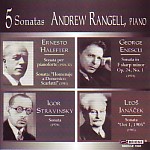Few pianists take on (let alone know about) George Enescu’s First Sonata, a work jam-packed with creativity and sophisticated invention. Perhaps they neglect it because the sonata’s so incredibly difficult to play! However, I’ll bet the detailed specificity with which Enescu applies dynamics, phrasings, tempo relationships, and expressive markings is enough to turn off pianists who’d rather just learn the notes, wow the public, and be done with it. Certainly Andrew Rangell can play the notes–and also create a paragraphic sweep that melts the barlines away. Yet the pianist’s frequent lack of attention to detail proves troubling.
He links the first movement’s opening octaves as one phrase unit rather than the two Enescu writes, and generally fails to distinguish “piano” markings from “pianissimos”. He rolls far more chords than Enescu wants arpeggiated, to the point of obscuring much of the movement’s polyrhythmic motion. Rangell also does not effectively articulate the Presto Vivace’s rapid shifts from marcato to staccato, even though he generates genuine excitement in the final climactic pages.
At first Rangell’s concentration, dynamic control, and wider color palette make a compelling case for his unusually protracted basic tempos in the third movement (more of a Largo than the Andante molto espressivo Enescu indicates). However, Rangell tends to get louder and more looser rhythmically as the notes pile up and the textures grow increasingly complex. Listen to Luiza Borac’s recent recording for Avie and you’ll encounter an altogether higher level of pianistic and interpretive refinement and character.
Rangell’s sincerely intended yet stylistically misguided phrase taperings and rubatos within the Stravinsky sonata’s first two movements is the musical equivalent of fitting a square peg into a round hole. Although Rangell “stage whispers” the softest, starkest moments of Janácek’s sonata and pounces upon the repeated chords like Horowitz devouring Scriabin, he’s genuinely attuned to this composer’s idiom. Rangell’s energetic, impulsive performance of Ernesto Halffter’s short sonata (imagine Granados re-writing Bach/Busoni with intentional wrong notes every now and then) contrasts to Adam Kent’s straighter, more Apollonian recording (also on Bridge). So does Rangell’s witty, sharply etched, almost cartoonish way with the same composer’s “Homenaje a Domenico Scarlatti”.
Overall, Rangell’s success in the Janácek and Halffter selections helps explain Bridge’s commitment to this headstrong, quirky, curiously uneven, and undeniably talented pianist. But why such closely miked, monochrome, and unalluring sonics?
































